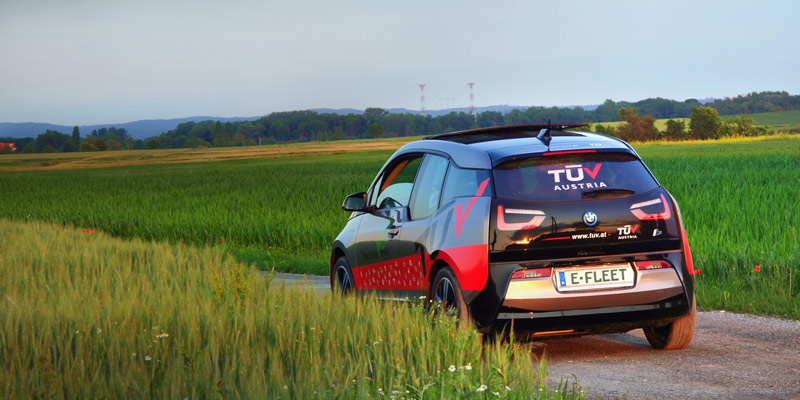On the road to the vehicle fleet of the future
- 09/15/2017
- Created by Christiane Reitshammer, Marcus Fehringer
The number of electric cars in Austria is currently about 10,300. For a total of 4.8 million passenger cars, that is still low, but the trend is rising. According to Statistics Austria, 1,226 electric cars were purchased in the first quarter of 2017 alone (up by 24% over the same period in 2016). A decisive factor for this increase in Austria is to a large extent the “Action Package for the Promotion of Electric Mobility”, which was put together by the ministries BMLFUW [Federal Ministry of Agriculture, Forestry, Environment and Water Management] and bmvit [Austrian Ministry for Transport, Innovation and Technology] along with domestic automobile importers. Since April there have also been new green license plates for electric and fuelcell cars. These provide some advantages to their e-drivers at the municipal level: free parking in several cities, including Graz, Klagenfurt, Villach, Innsbruck, Krems and
Wels.
New challenges
Companies with vehicles of their own in use have to react. “E-mobility is frequently justified
in terms of one’s CO2 footprint,” explains Christian Rötzer, CEO of TÜV AUSTRIA Automotive. “In entrepreneurial practice, however, more important factors involve benefits concerning technical and business management matters.” Statutory and innercity requirements are also becoming more
and more important. “There are now places where it is not allowed to drive a traditional diesel engine. So, requirements regarding noise exposures and emission loads are pointing noticeably toward e-mobility,” said Rötzer.
There is still skepticism among decisionmakers as to whether e-mobility will be an issue in the future, but it is just those opinion leaders who could push it forward. “Electromobility needs role models. Decisionmakers pave the way for sustainable mobility behavior, with 60% of new passenger car
registrations being done in and through corporate fleets and public transport vehicle fleets,” says Heimo Aichmaier, CEO of Austrian Mobile Power, a platform for promoting e-mobility with representatives from the vehicle, infrastructure, energy and user-technology sectors. “Public decisionmakers and companies operating sustainably need to be interested in low-emission, nonfossil-
driven electric vehicles, not only because they turn out to be profitable, but because it is CSR/sustainability in practice.”
Investments & economic factors
Alternatives are therefore necessary, but it is necessary for infrastructure and technical
developments to be in step with the process. Car manufacturers and suppliers are
continually investing in this future. Continental, one of the world's largest suppliers, is
investing an additional €300 million in the electric propulsion system business.
In Austria, e-mobility is to yield about 33,900 new jobs by the year 2030 and, according to
Austrian Mobile Power, has value-added potential of €3 billion. “Electromobility is gaining massive popularity all over the world. All manufacturers are banking on electrification of vehicle propulsion,
not only to evade dependence on fossil fuel sources in transport, but also to achieve the fleet CO2 target of 95g of CO2/km on schedule in 2021,” explains Aichmaier.
E-mobility in Austria should obtain even more momentum by an across-the-board supply network of e-service stations to prevent waiting times at stations and excessively long recharge times. “Electric vehicles always get charged while they are waiting for their users, i.e., when they are parked. For this purpose, charging infrastructures are needed that are technically reliable, locatable, highperformance
and in line with demand, because 80 percent of chargings are done at one’s place of residence or place of work,” says Aichmaier.
ÖHUB, a nationwide charging network for electric vehicles, has been used for this since April, with eleven major energy suppliers participating. 2,000 stations are planned for by the end of the year and 5,000 by 2020. Also offering a comprehensive charging system is Smatrics, a Verbund subsidiary, in cooperation with OMV.
The Smatrics network currently has around 400 charging points throughout Austria. To begin with, the network is to be expanded in Austria and Germany. Later, possible expansion will be considered to the
Czech Republic, Slovakia, Slovenia and Hungary.
Assistance for companies
“With good guidance and intelligent solutions, companies can design and deploy good charging systems not only for their own fleets, but also for their employees,” Aichmaier points out. To TÜV AUSTRIA, e-mobility is not just a key issue for the future, but a mission. E-fleet offers a comprehensive solution for the challenges facing vehicle fleets of the future. Customers benefit from cross-sectoral know-how in the fields of vehicle fleet optimization and administration, electrical mobility, energy efficiency (EnEffG transport), infrastructure (charging stations, photovoltaic systems and battery
storage systems) as well as subsidies.
This comprehensive approach does not just include the car itself, but also comprises charging management at company locations as well as all business-management-related issues. “First, we draw up a conceptual and customized solution for our customers. Customers each have completely different requirements for their vehicle fleets, and the concept chosen has to be geared to them,” the TÜV AUSTRIA expert Rötzer explains. An e-fleet should turn out to be profitable as the result of a plan of action with concrete proposals for implementation and optimization. “In addition, we factor in all tax effects, such as the tax base for payroll tax and fringe benefits.”
International Trends
As is well known, the electric car business is still a niche market. When it will turn into
big business is, as already mentioned, controversial. Some experts assume that fossil fuels will continue to dominate for a long time to come. Nevertheless, virtually all major manufacturers are committed to electric mobility.
With an eye view toward the constantly growing Chinese market, this is probably also a strategic decision. That would be because China wants one-fifth of vehicles sold in the country to have electric or hybrid propulsion systems by 2025. According to plan, that will then be nearly seven million vehicles annually. A threat to the established OEMs is also involved. That is to say, the People’s Republic wants to promote the production of alternative drive systems from Chinese manufacturers, hoping they will also gain a foothold abroad in the future.
Germany, on the other hand, has again bid farewell to its electric-car target (of one million vehicles) by 2020. Daimler boss Dieter Zetsche does not believe in this target either, which, however, “is no drama”. The corporate group is remaining faithful to its line and is continuing to press further ahead with the production and development of e-models. Zetsche has stressed several times that “emission-free driving is at the heart of the Group’s strategy”. By 2025, the proportion of e-vehicles is to make up 25 percent of the company's total sales.
VW is also pursuing a similar goal. The Wolfsburg-based company wants to become market leader in electromobility by 2025 and sell one million battery-powered cars annually.
GM, on the other hand, has set itself the ambitious goal of being the first carmaker to make profits on electric cars. “We are working on lowering the cost of such cars and being able to offer them at an affordable price”, Mark Reuss, the executive vice president for product development, explained.
It is well known that BMW is also operating in the electric car field - but not with sufficient commitment to its shareholders’ liking. US-American and Chinese companies are now leading the technology’s advancement, as the Deutsche Schutzvereinigung für Wertpapierbesitz (DSW) criticized. BMW boss Harald Krüger sees it differently: “We’re making rapid progress. The electric BMW i3 is one of the three most widely sold electric cars worldwide.”
In the first quarter, the “star” company Tesla became acutely aware of the fact that the e-car business cannot yet be described as a sure-fire success. Though new records had again been achieved in production, delivery and sales, the company fell even further into the red.
The Internal Combustion Engine Remains a Topic of Research
Despite the media hype surrounding the e-propulsion system, the swan song of the internal combustion engine is still in the far distance. This is also the opinion of researchers at the Graz University of Technology, for example. According to Helmut Eichlseder, head of the Institute of Internal Combustion Engines and Thermodynamics at Graz University of Technology, research into the internal combustion engine is “more necessary than ever”, despite the trend toward alternative propulsion systems.
As he sees it, “electric mobility is a very interesting option, especially for urban transport”, but the internal combustion engine will by far remain the engine of choice for many applications, such as long-distance transport vehicles, agricultural machinery, high-powered construction machinery and cargo ships.

